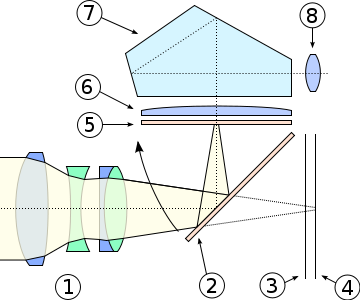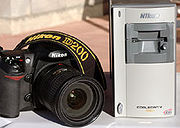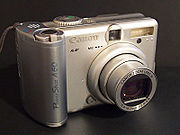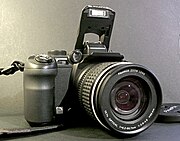Digital single-lens reflex camera
A digital single-lens reflex camera (digital SLR or DSLR) is a digital camera that uses an automatic mirror system and pentaprism to direct light from the lens through the viewfinder.
The basic operation of a DSLR is as follows: for viewing purposes, the mirror reflects the light coming through the attached lens upwards at an approximately 90 degree angle. It is then reflected by the pentaprism to the photographer's eye. During exposure (when the photograph is taken), the mirror swings upward, allowing the lens to project light onto the image sensor.
This is a major difference from an ordinary digital camera (digicam), which typically exposes the sensor constantly to the light projected by the lens, allowing the camera's screen to be used as an electronic viewfinder. In contrast, the mirror arrangement in a DSLR usually precludes the ability to view the scene on the LCD display screen before the photograph is taken. However, many newer DSLR models feature live preview, allowing LCD display to be used as a viewfinder in the same way as a normal digicam, although with certain limitations and with the optical viewfinder disabled.
In most other respects, a DSLR is similar in principle and operation to a standard (non-SLR) digital camera.
DSLR design principles

Cross-section view of SLR system.
1 - 4-element lens
2 - Reflex mirror
3 - Focal-plane shutter
4 - Sensor
5 - Matte focusing screen
6 - Condenser lens
7 - Pentaprism
8 - Eyepiece
A camera based on the single-lens reflex (SLR) principle uses a mirror to show the image that will be captured in a viewfinder. The cross-section (side-view) of the optical components of an SLR shows how the light passes through the lens assembly (1), is reflected into the pentaprism by the reflex mirror (which must be at an exact 45 degree angle) (2) and is projected on the matte focusing screen (5). Via a condensing lens (6) and internal reflections in the roof pentaprism (7) the image is projected, either focused or unfocused through the eyepiece (8) to the photographer's eye. Focusing is usually automatic, activated by pressing half-way on the shutter release or a dedicated AF button, as is mainly the case with an autofocusing film SLR; or manual, where the photographer manually focuses the lens by turning a lens ring on the lens barrel. When an image is photographed, the mirror moves upwards in the direction of the arrow, the focal-plane shutter (3) opens, and the image is projected and captured on the sensor (4), after which actions, the shutter closes, the mirror returns to a critical 45 degree angle, and the diaphragm reopens and the built in drive mechanism retensions the shutter for the next exposure.
Fast phase-detection autofocus
The diagram shown here is an over-simplification in that it omits the sensors used to drive the autofocus system.
DSLRs typically use a phase detection autofocus system. This method of focus is very fast, and results in less focus "searching", but requires the insertion of a special sensor into the optical path, so it is usually only used in SLR designs. Digicams that use the main sensor to create a live preview on the LCD or electronic viewfinder need to use the slower contrast method of autofocus.
DSLR optical viewfinder vs. digicam LCD display
Depending on the position of the reflex mirror (down or up), the light from the scene can only reach either the viewfinder or the sensor. Therefore, most DSLRs do not currently provide "live preview" (allowing focusing, framing, and depth-of-field preview using the display), a facility that is always available on digicams.
The advantages of an optical viewfinder are that it alleviates eye-strain sometimes caused by electronic view finders (EVF), and that it constantly shows (except during the split second of time for the sensor to be exposed) the exact image that will be exposed because its light is routed directly from the lens itself. Compared to ordinary digital cameras with their LCD displays and/or electronic viewfinders the advantage is that there is no time lag in the image; it is always correct as it is being "updated" at the speed of light. This is important for action and/or sports photography, or any other situation where the subject or the camera is moving too quickly. Furthermore, the "resolution" of the viewed image is much better than that provided by an LCD display or an electronic viewfinder, which can be important if manual focusing is desired for precise focusing, as would be the case in photomacrography or photomicrography (commonly referred to as "macro-photography" and "micro-photography").
Compared to some low cost cameras that provide an optical viewfinder that uses a small auxiliary lens, the DSLR design has the advantage of being parallax-free; that is, it never provides an off-axis view.
A disadvantage of the DSLR optical viewfinder system is that it prevents the possibility of using the LCD display for viewing and composing the picture before taking it. Some people prefer to compose pictures on the display – for them this has become the natural way to use a camera. LCD displays and electronic viewfinders may also provide a brighter display in low light situations, as the picture can be electronically amplified; conversely, LCD displays can be difficult to see in very bright sunlight.
DSLRs with live preview
A fairly recent development in DSLRs is the emergence of live preview options, which make it possible to use either the optical viewfinder or the LCD display when composing the picture (but not both). This can be an advantage because some people simply prefer to use the display and because in some situations it is not convenient or possible to hold the camera up to your face to look through the viewfinder. Underwater photography, where the camera is enclosed in a plastic waterproof case, is an example of a situation where composing on the display is preferred.
Olympus introduced the first DSLR with live preview, the Olympus E-330, in the spring of 2006. Since then other manufacturers have launched DSLR models with live preview, and the possibility exists that eventually all new DSLRs will have this feature.
As of the summer of 2007, the Canon EOS-1D Mark III, Canon EOS-1Ds Mark III, Canon EOS 40D, Nikon D3, Nikon D300, Olympus E-330, Olympus E-410, Olympus E-510, Panasonic Lumix DMC-L1, Panasonic Lumix DMC-L10 and Leica Digilux 3 all provide continuous live preview as an option. Additionally, the Fujifilm FinePix S5 Pro offers 30 seconds of live preview.
A new feature via a separate software package introduced from Breeze Systems in October, 2007, features live view from a distance. The software package is named "DSLR Remote Pro v1.5" and enables support for the Canon EOS 40D and 1D Mark III.[1]
DSLR lenses
-
The ability to exchange lenses, to select the best lens for the current photographic need, and to allow the attachment of specialized lenses, is a key to the popularity of DSLR cameras.

Nikon D200 digital SLR with a 12-24mm Nikkor zoom lens
Lens mounts and lens manufacturers
Interchangeable lenses for SLRs and DSLRs are built to operate correctly with a specific lens mount. A photographer will often use lenses made by the same manufacturer as the camera body (for example, Canon lenses on a Canon body). There are also many independent lens manufacturers, such as Sigma, Tokina, and Vivitar, to name a few, that make lenses for a variety of different lens mounts. There are also lens adapters that allow a lens for one lens mount to be used on a camera body with a different lens mount, but with reduced functionality.
Many lenses are mountable, "diaphragm-and-meter-compatible," on modern DSLRs and on older film SLRs that use the same lens mount. For more information see Mount compatibility across camera generations.
DSLR design considerations
Pentaprism vs. penta-mirror
Some DSLR's use a pentamirror instead of the traditional pentaprism. The pentamirror design is composed mostly of plastic and is lighter and cheaper to produce. Pentaprisms provide larger and brighter images through the viewfinder.[citation needed]
Sensor size and quality

The Kodak DSC Pro SLR/c: a full-frame DSLR using Canon EOS mount lenses. This camera is currently discontinued. Canon has their own camera, the EOS 5D with full-frame CMOS sensor.
The image sensor in a DSLR is typically much larger than the one in a consumer-level digicam. A larger sensor allows better image quality, lower noise, shallower depth of field, higher sensitivity, and increased latitude and dynamic range. The SLR design allows the use of such large sensors as the main sensor is typically only exposed while the picture is being taken, in contrast to the typical 'digicam' design which uses the sensor to provide live view. Continuous operation of the large sensors required for low-noise images would result in sensor heating that could reduce image quality.[2]
Many DSLR sensors are roughly APS-sized, that is, approximately 22 mm × 15 mm, a little smaller than the size of an APS-C film frame, much smaller than a frame of 135 film.
High-end digicams such as the Nikon Coolpix 8400 and the Coolpix 8800 have an 8.8 by 6.6 mm sensor (2/3 inch format, 11 mm diagonal), about five to seven times smaller area than a typical DSLR sensor.
Lower-end digicams have even smaller sensors, which usually, but not always, results in lower image quality than DSLRs. Some digital SLRs have sensors the same size as 35mm film; such cameras are referred to as "full-frame" cameras and are generally much more expensive. The Canon EOS 1Ds, the Canon 5D, and the Nikon D3 are examples of cameras using a full-frame sensor.
Depth-of-field control
The larger size of the sensors (and therefore lens focal lengths) of DSLRs compared to digicams makes it much easier to limit the depth of field, for example to emphasize a face by blurring the background. This reduced depth of field can be a disadvantage when the photographer prefers to take pictures where as much of the scene as possible is sharply rendered.
Note that DSLR's typically have lens apertures smaller than the typical digicam's aperture setting ability, which is usually f/8. This is a limitation of the small sensor. In contrast, a DSLR can 'stop down' to f/16, f/22 or smaller aperture, depending upon the lens mounted on the camera and its f/stop range.
Angle of view
The angle of view of a lens depends upon its focal length and the camera's image sensor size; a sensor smaller than 35mm film format (36mm × 24mm frame) gives a narrower angle of view for a lens of a given focal length than does a camera equipped with a full-frame (35mm) sensor. As of 2007, only a few current DSLRs have full-frame sensors, including the Canon EOS-1Ds Mark II, the Canon EOS 5D, and the Nikon D3. The scarcity of full-frame DSLRs is partly a result of the cost of such large sensors. Medium format size sensors, such as those used in the Mamiya ZD among others, are even larger than full-frame (35mm) sensors, and capable of even greater image quality, but are even more expensive.
The impact of sensor size on field of view is referred to as the "crop factor" or "focal length multiplier", which is a factor by which a lens focal length can be multiplied to give the full-frame-equivalent focal length for a lens. Roughly APS-sized sensors have a crop factor of 1.5 to 1.7, so a lens with a focal length of 50mm will give a field of view equal to that of a 75mm to 85mm lens on a full-frame camera. This crop factor makes achieving long telephoto images on an APS-sensor camera easier than on a full-frame camera, though wide-angle views suffer by the same amount. Shallow depth-of-field images also tend to be more limited, since the wider the lens you use the more depth of field you get, so the smaller the sensor the more depth of field with the same f-number and field of view.
Mode dial
Digital SLR cameras, along with most other digital cameras, generally have a mode dial to access standard camera settings or automatic scene-mode settings. Sometimes called a "PASM" dial, they typically provide as minimum Program, Aperture-priority, Shutter-priority, and full Manual modes. Scene modes vary and are inherently less customizable. They often include full-auto, landscape, portrait, action, macro, and night modes, among others. Professional DSLRs seldom contain automatic scene modes because professionals understand their equipment and can quickly adjust the settings to take the image that they want.
Medium format digital
Many medium format roll-film SLRs can accept a digital camera back to turn the camera into a DSLR with very high image resolution and quality (typically 22–39 megapixels as of January 2007). However, the combination is very expensive and bulky, and more suited to still life than to action photography.
As of 2007 integrated medium formats like the Hasselblad H System[3] and Leaf AFi[4] have started to appear.
Unusual features – infrared and ultraviolet photography
On July 13, 2007, FujiFilm announced the FinePix IS Pro, which uses Nikon F-mount lenses. This camera, in addition to having live preview, has the ability to record in the infrared and ultraviolet spectrums of light.
























